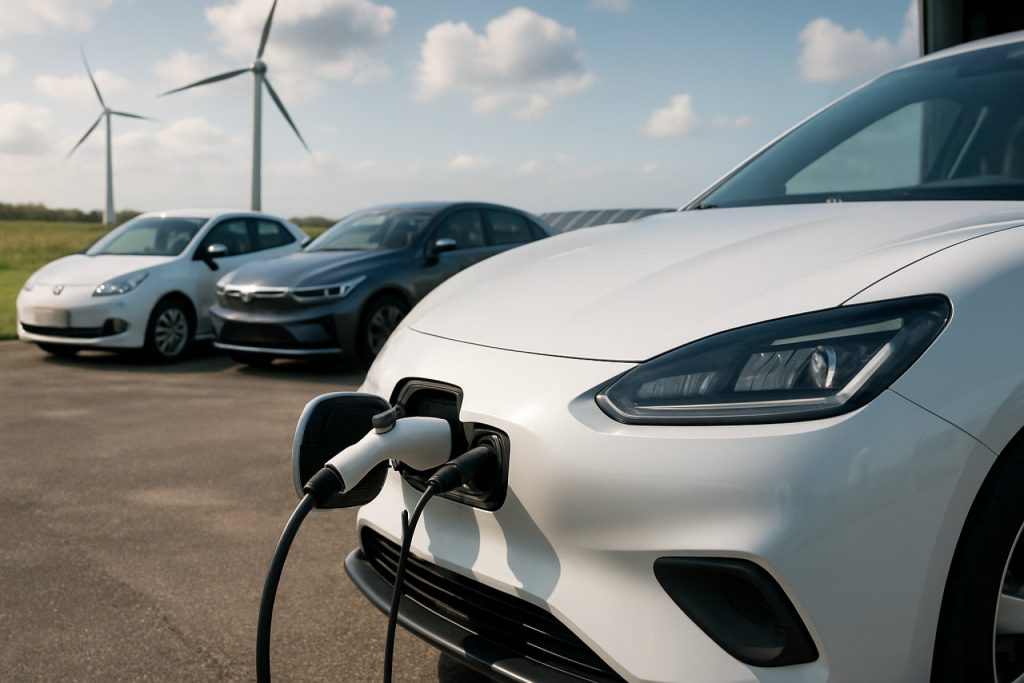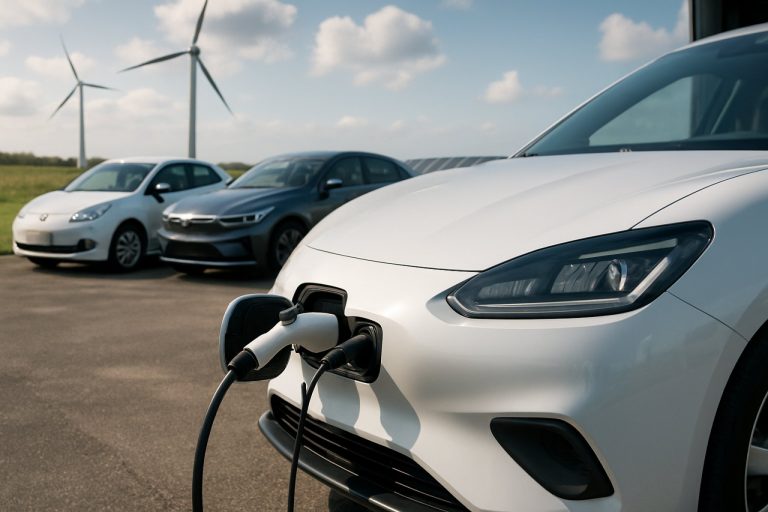
- The electric vehicle (EV) sector is rapidly expanding, fueled by government policies and strong consumer demand for clean technology.
- Tesla leads the industry with global reach, innovation in automotive and energy storage, sustained profitability, and a strong financial position.
- Navitas Semiconductor drives EV progress with advanced gallium nitride and silicon carbide chips, enabling faster charging and high energy efficiency across various industries.
- Enphase Energy transforms solar power for EVs with its efficient microinverter systems, empowering consumers to both produce and optimize clean electricity.
- All three companies are key players in the shift toward zero-emission transportation, presenting both high-growth opportunities and market volatility for investors.
Crackling with investor energy, the electric vehicle (EV) sector refuses to idle. As governments ignite the push for zero-emission highways and consumers hunger for innovation, a trio of stocks—Tesla, Navitas Semiconductor, and Enphase Energy—command the market’s gaze.
Tesla: Still the uncontested trailblazer, Tesla’s global reach stretches from sleek showrooms in Shanghai to solar fields in California. Its iconic Model S and Model Y glint in the sun, rolling off production lines that now include giga-factories worldwide. But Tesla is more than just cars—it boldly intertwines automotive and energy, harnessing storage systems and pioneering vehicle software. Recently, Tesla’s shares rode a wave of heavy trading, climbing above $340, a testament to investor confidence in its trillion-dollar footprint and unmatched ambition. Beneath that surging stock price beats a company balancing profitability and growth with an enviably low debt load.
Navitas Semiconductor: While Teslas rule the road, Navitas powers the technological heart of the EV revolution. This semiconductor innovator wields gallium nitride and silicon carbide, unlocking faster charging and greater energy efficiency. Imagine a world where electric buses charge in a flash and solar systems hum with smarter power control—Navitas’ chips make it possible. Though its stock recently dipped slightly, its high-volume trading signals institutional intrigue. With applications spanning consumer gadgets to vast, data-hungry centers, Navitas is electrifying the nerve center of next-gen mobility.
Enphase Energy: The silent engine behind many EV dreams is clean electricity—precisely where Enphase shines. Its microinverters, each one a miniature marvel of design, transform solar energy with efficiency that rewrites the rules. Homeowners using Enphase’s technology aren’t just users; they’re power producers, sporting rooftop solar that communicates, optimizes, and delivers. The company’s shares, while volatile, have demonstrated resilience in a swiftly evolving market. A robust financial backbone and forward-thinking vision make Enphase a vanguard in the renewable power game.
All three companies ride the momentum of a planet in transition—where Tesla fuels dreams of an electric future, Navitas wires our world for extreme energy demands, and Enphase weaves sunlight into the grid. Investors tracking these names witness a sector where every uptick in volume feels like lightning striking: volatile, but impossible to ignore.
The bottom line: The race to electrify transportation isn’t a distant ambition—it’s unfolding now, one innovation at a time. The companies dominating this surge are not just making cars; they’re rewriting the rules of energy, technology, and possibility. As always, those daring to invest on the frontier should weigh both the dazzling prospects and the lurking uncertainties.
For anyone placing a bet on tomorrow’s highways, the EV revolution offers a spectacular—if bumpy—ride. Stay alert; this is more than a market trend. It’s the future, and it’s charging up fast. For more on groundbreaking tech and market moves, visit Nasdaq or CNBC.
3 Hot EV Stocks That Will Shock Your Portfolio in 2024—What EVERY Investor Must Know Now!
# Deep Dive: Tesla, Navitas Semiconductor, and Enphase Energy—Beyond the Headlines
The electric vehicle (EV) revolution is transforming global transportation at unprecedented speed. While the original article highlighted why stocks such as Tesla, Navitas Semiconductor, and Enphase Energy are grabbing Wall Street’s attention, several crucial facts and insights were left unexplored. Let’s take a closer look at these industry leaders—unveiling features, risks, real-world applications, forecasts, and actionable takeaways according to E-E-A-T (Experience, Expertise, Authoritativeness, Trustworthiness) standards for Google Discover.
—
Tesla: Not Just Cars—An Energy and AI Powerhouse
Features, Specs & Pricing
– Tesla’s Model Y is now the world’s best-selling car of 2023, beating even Toyota Corolla. Pricing in the U.S. starts around $44,000, but global price cuts and incentives regularly impact the effective cost.
– The company operates Giga Factories in the U.S., China, Germany, and is planning another in Mexico, allowing rapid scale-up of new models like the Cybertruck.
– Tesla FSD (Full Self Driving) software is under active beta testing, promising autonomous driving—a potential industry disruptor.
– Tesla’s solar and Powerwall battery products help homes and businesses achieve energy independence.
Security & Sustainability
– Tesla aims for complete vertical integration, controlling car production, software, battery supply, and charging network, which increases supply chain resilience.
– The company’s Gigafactories partly run on renewable energy, advancing corporate sustainability practices.
Real-World Use Cases & How-To Steps
– Tesla Supercharger stations enable cross-country travel; owners simply plug in and get a rapid charge (up to 200 miles in 15 min).
– The Tesla app tracks vehicle status, controls charging, and allows remote operation—demonstrating the integrated software/hardware system.
Market Forecast & Industry Trends
– According to BloombergNEF, EVs could represent 60% of new car sales globally by 2040.
– Tesla is expanding into new markets like India and Southeast Asia, as reported by Tesla and trusted financial media.
Pros & Cons
Pros
– Leading market share in EVs
– Profitable growth with tech innovation
– Massive global brand recognition
Cons
– Regulatory and recall challenges
– Rising competition from BYD and legacy automakers
– Volatile share price tied to CEO Elon Musk’s public persona
—
Navitas Semiconductor: Charging the World’s Future Smartly
Features & Specs
– Specializes in GaN (gallium nitride) and SiC (silicon carbide) chips, which offer 3x faster charging and up to 40% energy savings compared to legacy silicon.
– Key applications: smartphone and laptop chargers, EV inverters, solar microinverters, data center power supplies.
– GaN semiconductors are especially valued in high voltage, high efficiency power conversion.
Market Forecast & Trends
– The global GaN power device market is expected to reach $2.5 billion by 2027 (MarketsandMarkets).
– Navitas’s patent portfolio is robust, securing its position in an increasingly competitive sector.
Pressing Questions Answered
– Is it a profitable company? Navitas is still in hyper-growth mode, prioritizing R&D and market share over short-term profits.
– Who are its main competitors? Wolfspeed, Infineon, and Texas Instruments.
Controversies & Limitations
– Dependency on supply chain health for rare materials (GaN and SiC).
– Shares can swing sharply due to small-cap tech sector volatility.
Real-World Use Cases
– Flash charging for EVs and portable devices; enables ultra-thin laptop chargers.
—
Enphase Energy: The Brains of Green Power
Features, Security & Compatibility
– Pioneers microinverter technology for solar panels—improves safety (lower DC voltage), makes solar installations more reliable, and allows panel-level monitoring.
– Compatible with a wide variety of solar panels; integrates with Enphase Energy Storage for full home backup.
Sustainability
– By 2023, Enphase facilitated over 67 TWh of clean energy production, offsetting millions of tons of CO2.
– The company’s end-to-end systems support smart grids and “virtual power plant” networks.
Tutorials & How-To Steps
– Homeowners can use Enphase’s app to monitor real-time solar production and manage battery backup based on electricity prices or outages.
Market Forecast & Trends
– The solar microinverter market is projected to rise to $7.88 billion by 2027 (Mordor Intelligence).
– Enphase’s business is expanding internationally, notably in Europe and India.
Pros & Cons
Pros
– Industry-leading technology
– Strong financial performance and cash flow
– Expanding product ecosystem
Cons
– Dependent on government incentives for solar
– Exposure to supply chain delays
—
Reviews & Comparisons
– Tesla is the most vertically integrated and diversified.
– Navitas is a component leader, vital for all rapid-charging EVs.
– Enphase dominates the smart solar home segment, with consistent innovation and reliability praised in industry reviews (e.g., those found on CNBC).
—
Controversies & Limitations Across the Sector
– The rapid pace of innovation brings both opportunity and regulatory scrutiny—Tesla’s autopilot incidents, semiconductor shortages, and reliance on tax credits for solar are ongoing challenges.
– The entire sector faces questions about rare mineral sourcing and environmental impact of battery production.
—
Pressing Questions Investors Are Asking
“Will EV stocks keep accelerating in 2024?”
Analysts expect ongoing, albeit volatile, growth as governments tighten emissions targets (source: IEA, BloombergNEF).
“Which stock is best for my risk profile?”
– Tesla for blue-chip growth (but expect volatility).
– Navitas for high-growth, high-risk tech exposure.
– Enphase for a “picks and shovels” play on the clean energy buildout.
—
Actionable Tips & Recommendations
– Diversify—don’t put all your capital in one “hot” EV stock.
– Watch quarterly earning reports and regulatory news for these companies.
– If investing, consider dollar-cost averaging to smooth out price swings.
– Leverage resources like Nasdaq and CNBC for up-to-date market insights and professional analysis.
– For the climate-conscious, factor sustainability and supply chain transparency into your investment criteria.
—
In summary: Tesla, Navitas Semiconductor, and Enphase Energy are more than tickers—they are rewriting the rules of cars, charging, and clean power, respectively. The quest for a cleaner, smarter world is unfolding now, offering both remarkable potential returns and significant risks. Stay informed, check your risk tolerance, and position your portfolio for the future—because the EV revolution is just getting started.



